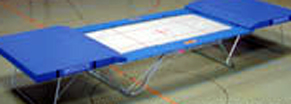

Although even in the early years of trampolining, notable American and international athletes performed many of the difficult skills and combinations of skills that are seen today, modern trampoline competitions are quite different those of the early developmental years -- due in part to advances in equipment design, changes in the rules and governance, and more systematic training of the athletes.
International competition trampolines are larger and more powerful than those utilized in the early years and a far cry from the "backyard" models that are found today in most American suburban neighborhoods. These modern trampolines can propel trained athletes as high as 30 feet in the air during performances! During two competitive routines of 10 skills each, upper-level athletes can easily demonstrate a graceful array of double, triple and twisting somersaults.
Synchronized trampoline demands the same athletic skill as individual trampoline, while adding the element of precision timing. Using two trampolines, two athletes perform identical 10-skill routines at the same time. In this most artistic event in the sport, each performs as a mirror image of the other, doubling the visual beauty of trampoline competition.
It has been said that the first type of trampolining was done by the Eskimos who used to toss each other up into the air on a Walrus skin something like the sheet used by firemen to catch people jumping out of the windows of houses which were on fire. In Anchorage airport, Alaska, there are postcards depicting the Eskimos being tossed up in a Walrus skin. There also is some evidence of people in England being tossed up into the air by a number of people holding a blanket.
Evidence suggests the Comanche Indians of North America used a type of trampoline at least as early as the mid-1800s, and circus acrobats have used devices resembling trampolines for at least 200 years.
The trampoline itself, according to circus lore, was first developed by an artist called Du Trampolin who saw the possibility of using the trapeze safety net as a form of propulsion and landing device and experimented with different systems of suspension, eventually reducing the net to a practical size for separate performance.
- The 30’s -
The manufactured trampoline, as we know it today, was created by two men, George Nissen and Larry Griswold, allegedly in George's garage. One day in 1935, with the help of the wrestling coach at the University of Iowa, Nissen and Griswold bolted together an iron frame. A piece of canvas, in which they had inserted grommets along each side, was then attached to the frame by using springs. This was the first trampoline. He used it to help with his diving and tumbling, then decided he could entertain audiences and let them participate in his demonstrations. Nissen called it a Trampoline after hearing "El trampolin" (Spanish for diving board), on a performance tour in Mexico around this time, and registered the term as a trademark.
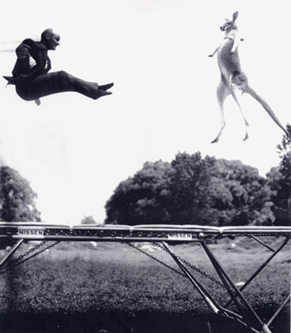
Georges Nissen invents the Trampoline.
- The 40’s -
During World War 2, the United States Navy Flight School developed the use of the trampoline in its training of pilots and navigators, giving them concentrated practice in orientation such as had never been possible before. After the war, the development of the Space Flight programme again brought the trampoline into use to help train both American and Soviet Astronauts, giving them experience of variable body positions in flight.
In 1942, Griswold and Nissen decided to formalise their small operation of making trampolines. They created the Griswold-Nissen Trampoline & Tumbling Company in Cedar Rapids, Iowa. It was Bob Bollinger of Rockford, Illinois who revolutionized judging of trampolining, introducing a system that is still being used today (with only a few modifications) separating the difficulty from the evaluation of the execution. Franck LaDue and Jim Norman wrote the world text book “Two seconds of Freedom”.
First American championships in 1948.
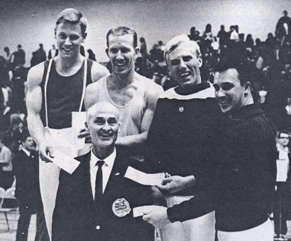
Trampolining is included as an event in gymnastics competitions by both the AAU and NCAA.
- The 50’s -
Trampoline lands in Europe by way of Great Britain, thanks to Ted Blake and to Switzerland via Kurt Baechler. In 1957 Kurt Baechler, who was working in California at the time, flew to Cedar Rapids, signed for Nissen, and together with Frank LaDue worked out a basic introduction to trampolining. They then took the sport to schools in Germany and Switzerland, and set up the Swiss Headquarters of the Nissen Trampoline Corp. in Kurt's home town of Gumligen, Switzerland. In 1958, after a trampoline competition in Zurich, the first international Nissen Cup was held in the town of Wasen, during the month of August.
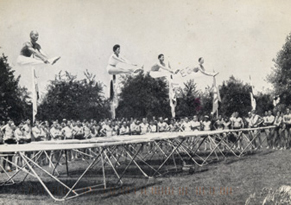
Trampoline lands in Europe by way of Switzerland, thanks to Kurt Baechler.
Scotland is the first to establish its National Federation in 1958.
- The 60’s -
On March 4, 1964, the International Trampoline Federation (FIT) is established in Frankfurt on the Main (GER).
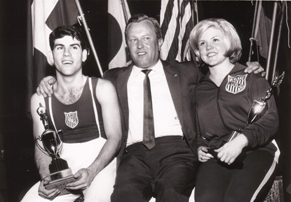
René Schaerer (SUI) is elected President.
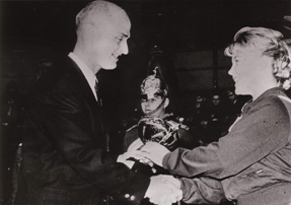
On March 21 of the same year, the Royal Albert Hall in London welcomes the first World Championships.
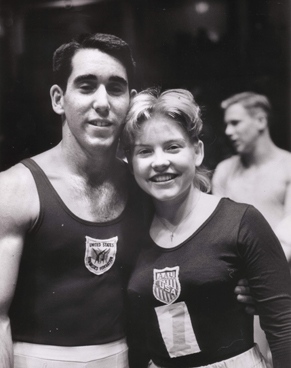
Dan Millmann and Judy Wills (USA) are the first champions.
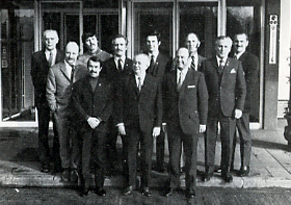
In 1968, Eric Kinzel (GER) becomes the new FIT President.
First edition of the European Championships in Paris (FRA).
- The 70’s -
Tumbling and Double Mini Trampoline make their appearance.
First “World Age Group” Competition.
- The 80’s -
First edition of the World Cup in Bois Colombe (FRA).
Trampoline’s first appearance in the World Games in London (GBR).
The FIT publishes the first edition of its official Bulletin.
In 1988, the IOC accepts the FIT as a federation.
- The 90’s -
Ron Froehlich (USA) takes over the Presidency.
1993: First edition of the World Cup Final in Frankfurt (GER).
1997: Last edition of the World Games for Individual Trampoline events in Lahti (FIN).
1999: The FIT is dissolved and as of January 1, Trampoline becomes a Fédération Internationale de Gymnastique (FIG) discipline.
Horst Kunze (GER) keeps the Chair of the Technical Committee.
The World Championships in Sun City (RSA) are qualifying for the Olympic Games in Sydney 2000.
- The years 2000 -
Trampoline goes Olympic in Sydney (AUS)! Alexander Moskalenko and Irina Karavaeva (RUS) are the first Olympic Champions in Trampoline.
2003: Karen Cockburn (CAN) becomes the first Non-European World Champion since 1974 (29 years later...)
2004: The Legend, Alexander Moskalenko (RUS) retires.
2007: Shuai Ye (CHN) becomes the first Non-European World Champion since 1970 (37 years later...) and the first Individual World Champion for Asia!
2008: Last edition of the World Cup Final in Togliatti (RUS).
- The years 2010 -
2010: George Nissen passes away at 96 years old.
First edition of the Individual and Synchronized World Championships in Metz (FRA).
The Time Of Flight is added as a judging criteria.